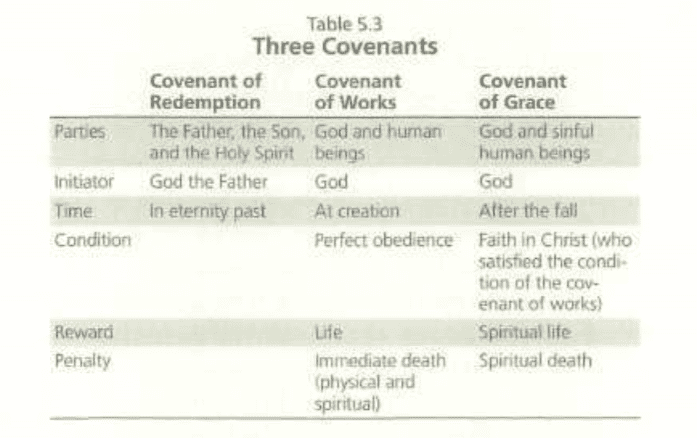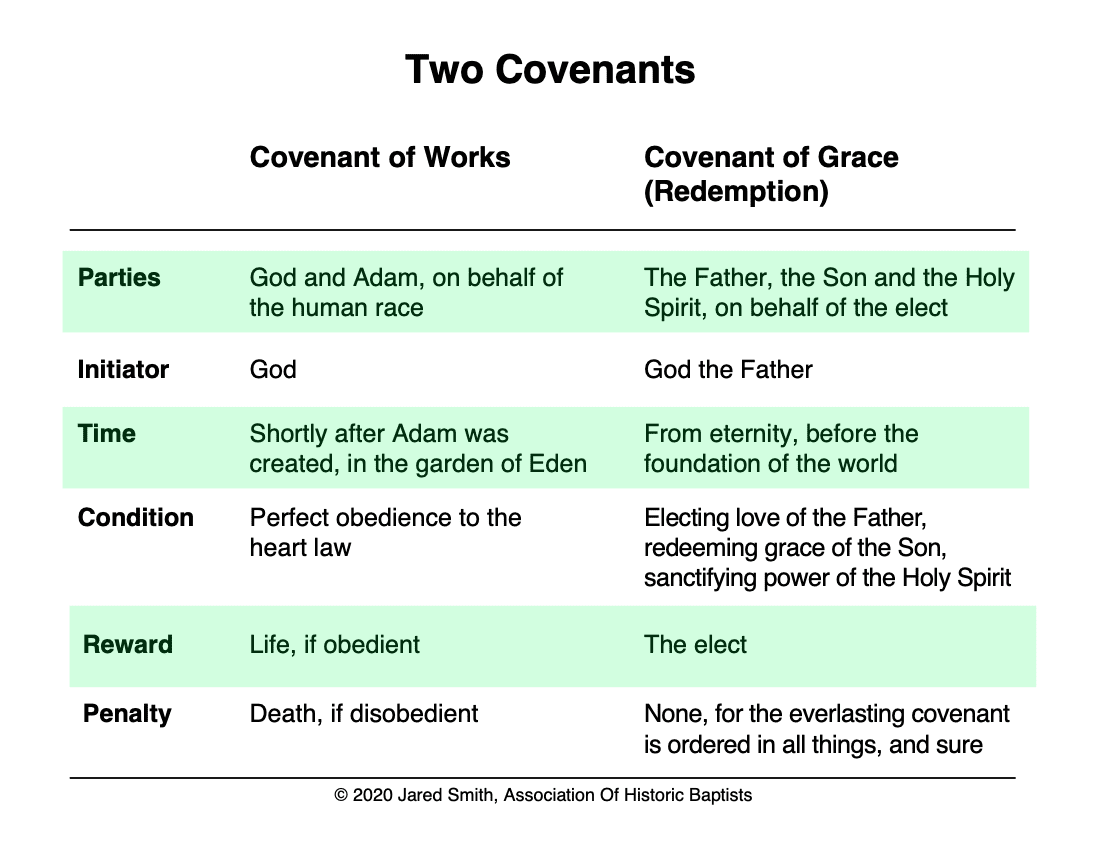
Two Or Three Covenants?
One of the reasons many Reformed believers assert it is the duty of all sinners to savingly believe on Christ is because they distinguish between the covenant of redemption and the covenant of grace. They believe the covenant of redemption was made between the Father, the Son and the Spirit from eternity, whereas the covenant of grace is made between Jehovah and the sinner in time. They view the covenant of redemption as existing in the background of God’s plan for the ages, whereas the covenant of grace is set in the foreground of man’s responsibility for today.
R. C. Sproul outlined this view in his book, “What Is Reformed Theology”. He explained Reformed Theology is primarily concerned with three major covenants—the covenant of redemption, the covenant of works and the covenant of grace.
With reference to the covenant of redemption, page 127:
“The first covenant we consider in the scope of Reformed theology does not directly include human beings, but is nevertheless critically important. The covenant of redemption involves the parties who work together to effect human redemption: the Father, the Son, and the Holy Spirit. This covenant is rooted in eternity.”
With reference to the covenant of works, pages 128,129:
”The initial covenant God made with mankind was a covenant of works. In this covenant, according to the Westminster Confession, “life was promised to Adam; and in him to his posterity, upon condition of perfect and personal obedience.” It is important to note that a “condition” is attached to this first covenant. The condition is personal and perfect obedience. This is a condition of works, and this is the covenant’s chief stipulation. Life is promised as a reward for obedience, for satisfying the condition of the covenant.”
With reference to the covenant of grace, pages 131,132:
“The Westminster Confession declares this about the covenant of grace: ‘Man, by his fall, having made himself incapable of life by that covenant, the Lord was pleased to make a second, commonly called the covenant of grace; wherein He freely offereth unto sinners life and salvation by Jesus Christ; requiring of them faith in Him, that they may be saved, and promising to give unto all those that are ordained unto eternal life His Holy Spirit, to make them willing, and able to believe.’
Perhaps the chief difference between the covenant of grace and the first covenant, and the reason why it is called a covenant of grace, is that this covenant is made between God and sinners. The covenant of works was made between God and his unfallen creatures. Once that covenant was violated and the fall had occurred, mankind’s only hope was rooted totally in grace.”
In an effort to help the reader better understand the relationship between these three covenants, Sproul includes this chart:
Here is my response:
First, I wish to highlight my view of the covenants.
1. A covenant is an agreement between two or more people, with certain obligations binding them together. There are three parts to every covenant—(1) the parties; (2) the conditions; (3) the rewards/penalties.
2. Every relationship is based upon the authority of a covenant. Whether it be the relationship between a husband and wife, or parent and child, or friend and friend, or citizen and government; every relationship is based upon those persons agreeing to certain conditions/obligations which will result in rewards or penalties. There cannot be a relationship without the authority of a covenant which binds the persons together.
3. The responsibility of an individual within a relationship is determined by the law (obligations) which bind the persons together under that covenant. For instance, the law (obligations) which is binding upon a husband and wife within a marriage covenant, is different from the law (obligations) binding upon parents and children within a family covenant. Henceforth, every covenant has its own law (obligations), and it is that law (obligations) which is binding upon the persons under that covenant. It is the law (obligations) under the authority of a covenant which defines a person’s responsibility, and it is according to that law under that covenant the persons are held accountable.
4. Relational conflict is the result of violating the law (obligations) of the covenant. If a husband fails to fulfill his obligations in the marriage, it will result in conflict; if a child fails to fulfill his/her obligations in the family, it will result in conflict; if a friend fails to fulfill his/her obligation in the friendship, it will result in conflict.
5. Relational conflict may be resolved in one of two ways—reconciliation or separation. Both solutions are legitimate and positive outcomes. Those who remain in a relationship without resolving the conflict in one of these two ways, will suffer perpetual conflict within that relationship.
6. The relationship humans have to or with God is based upon the authority of a covenant. The members of the human race are in relationship to or with God under the authority of one of two perpetual covenants—the covenant of works and the covenant of grace.
7. Unregenerate sinners are in relationship to God under the authority of the covenant of works. The covenant of works was made by God with Adam on behalf of the human race in the garden of Eden. God appointed Adam to serve as the covenant head of the human race, insomuch that he became the representative of all who would come into the world through his seed. Upon his heart God inscribed a twofold law, which I will call the heart law—first, to love God supremely; second, to love his neighbor as himself. The heart law was given to Adam under the authority of the covenant of works. He was responsible to exercise perfect obedience to this law, epitomized in God’s command to not eat of the fruit of the tree of the knowledge of good and evil. The consequence of disobedience would be condemnation and death. Since Adam did eat of that fruit, thereby transgressing the heart law, and violating the terms of the covenant of works, he not only brought upon himself condemnation and death, but also plunged the human race into the same state of sin and misery. This covenant of works (along with the heart law) is renewed with every person that is brought into the world. Furthermore, those who come into the world through natural generation (everyone, except Christ) are conceived in sin and shaped in iniquity, and therefore this covenant and its law, rather than serving as a blessing to the righteous, is a curse to the unrighteous.
8. Regenerate sinners are in relationship with God under the authority of the covenant of grace. The covenant of grace was made from eternity between the three Persons of the Godhead, on behalf of the elect. God the Father, having set His electing love upon a remnant of the human race, devised a plan to save them from their sins and deliver them from death and judgment. Henceforth, He gave the elect to His Son, appointing Him to serve as their Redeemer. The Son of God received them unto Himself, setting His love upon them, and agreeing to redeem them. Upon this pledge of the Son, the Father justified the elect by the redemption that would be in Christ Jesus. Forthwith, the Father and the Son gave the elect to the Holy Spirit, appointing Him to serve as their Sanctifier. The Spirit of God received them unto Himself, setting His love upon them, and agreeing to sanctify them. In this way, the TriUne Jehovah has prepared His people unto glory. All conditions of this covenant are binding upon the there Persons of the Godhead, and the reward is therefore received by the Father, the Son and the Spirit, as they secure their people by electing love, redeeming grace and sanctifying power. Although the covenant of grace was drawn up by the TriUne Jehovah from eternity, it is made known to each of God’s elect people at the appointed time throughout the course history. This began with the Spirit of God regenerating Adam and Eve after they transgressed God’s law, and it continues today with the Spirit of God regenerating sinners by that same power and grace.
9. So long as unregenerate sinners remain in that condition, they are duty bound to perfectly obey the heart law under the authority of the covenant of works. It is under this covenant and according to the heart law, God holds the unregenerate sinner accountable. Although, as sinners, they cannot perfectly obey the heart law, yet their inability does not negate their responsibility before God. They are responsible to love Him supremely and to love their neighbor as themselves.
10. When a sinner is regenerated, the Spirit of God unites the soul with the Lord Jesus Christ, as a branch is engrafted to a vine. Consequently, not only does the life of Christ flow into the soul, making him/her alive unto God, but the virtue of Christ also flows into the soul, issuing in the fruit of the new nature, among which is saving faith and repentance. I will call this new nature the gospel law. It is in this way the sinner is experientially delivered from the authority and curse of the covenant of works, and is brought under the authority and blessings of the covenant of grace. Thereafter, it is the duty (or privilege) of the regenerate sinner to believe on Christ to the saving of the soul, for he/she is now duty bound to obey the gospel law under the authority of the covenant of grace. Forthwith, it is under this gracious covenant and according to the gospel law, the regenerate sinner is responsible before God—since he/she lives in the new nature, he/she is to walk in the new nature.
11. The covenant God made with Adam on behalf of the human race in the garden of Eden, must not be confused with the covenant God made with Moses on behalf of the nation of Israel on Mount Sinai. The Mosaic covenant was designed for and binding only upon the children of Israel as a nation, from the time they were constituted a nation (1491 BC) to the time the nation ceased to exist (AD 70).
Likewise, the heart law, belonging to the covenant of works, and the gospel law, belonging to the covenant of grace, should not be conflated with the Mosaic law, belonging to the Mosaic covenant. For instance, while the ten commandments, otherwise known as the moral law, was an application of the heart law for the children of Israel, yet it was not designed to replace the heart law under the covenant of works, neither was it intended to be binding on anyone other than the Jewish people as a nation. Once more, while the ceremonial law was an expression of the gospel law under the covenant of grace, yet it was designed to serve only as a picture of the gracious covenant and a pointer to the gospel. Therefore, while there are elements in the Mosaic covenant that point to the covenant of works and to the covenant of grace, yet it is an entirely separate covenant from both.
With this in mind, the scriptures must be read with much care. When the New Testament speaks about the Mosaic law, it has particular application to the Jewish people who were at that time still under its yoke, either covenantally or culturally. We must not think of ourselves today or of the Gentiles in the New Testament era, as ever having been under the Mosaic law. There are only two perpetual covenants that have been operative throughout the course of history, and binding upon the human race (Jews and Gentiles)—the covenant of works (heart law) and the covenant of grace (gospel law).
12. The New Covenant, referred to by the prophet Jeremiah, the Lord Jesus Christ and the Apostle Paul, is not an actual covenant. Rather, it is an explanation to the Jewish people as a nation of the Covenant of Redemption, within the context of the Mosaic economy and its laws. Properly speaking, the Covenant of Works and the Covenant of Redemption have been active since the garden of Eden, with God administering (dispensing) both covenants to His elect and non-elect people. These spiritual covenants are the parameters around which God relates to the members of the human race, irrespective of the earthly covenants God made with men such as Noah, Abraham, Moses and David. Henceforth, when it was prophesied to the Jewish people their nation would come to an end, it was necessary to explain to them how they as a race would continue, and how the spiritual Covenant of Redemption remains applicable to them.
Second, I wish to highlight my disagreement with Sproul’s view of the covenants.
1. With regards to the covenant of works, I agree with the basic points listed in the diagram. (1) The Parties—God established this covenant with Adam, on behalf of the human race; (2) The Initiator—God initiated this covenant with Adam; (3) The Time—God established this covenant with Adam in the garden of Eden; (4) The Condition—God requires perfect obedience to the law inscribed upon the heart; (5) The Reward—Adam would receive life if obedient to the heart law; (5) The Penalty—Adam would incur death if disobedient to the heart law; (6) The Renewal—This covenant is renewed with the entire human race, and those brought into the world through Adam’s seed are conceived in sin and shaped in iniquity.
2. With regards to the covenant of redemption and the covenant of grace, I do not agree these are two separate covenants. By separating them, Sproul makes two fundamental errors:
(1) With reference to the covenant of redemption, Sproul subtracts the conditions and rewards belonging to the agreement between the three Persons of the Godhead. As you can see from his diagram above, he leaves these spaces blank. However, there are conditions binding upon the three Persons of the Godhead, without which there could be no covenant. What are these conditions? The first condition is election—the electing love of God the Father; the second condition is redemption—the redeeming grace of God the Son; the third condition is sanctification—the sanctifying power of the Holy Spirit. Again, he leaves blank the rewards earned and acquired by the Persons of the Godhead. What are these rewards? The elect. The Father receives a people He has chosen for Himself; the Son receives a people He has redeemed for Himself; the Spirit receives a people He has sanctified for Himself. Sproul rightly leaves blank the penalty, for this everlasting covenant is ordered in all things, and sure.
Now, this covenant of redemption is one and the same with the covenant of grace. The labels are used interchangeably. When we speak about the covenant of redemption, or the covenant of grace, we are talking about the TriUne Jehovah’s complete work of salvation on behalf of the elect. There is no other covenant God has made with sinners under which they can or must be saved. The covenant of redemption/grace is conditioned only upon the three Persons of the Godhead. It is a full gospel of election, redemption and sanctification. It is a free gospel, there being no conditions on the part of a sinner in order to be redeemed or regenerated. However, Sproul uproots the fulness of the gospel, undermining its integrity and rendering it unfree by making it conditional upon the faith of a sinner. Henceforth, we come to the next error.
(2) With reference to the covenant of grace, Sproul, in accordance with the Reformed tradition, views it as an entirely different covenant than that of redemption. Under this third covenant, a list of items are added as necessary unto salvation:
(1) The Parties—God enters a covenant with the sinner;
(2) The Initiator—God initiated this covenant in time;
(3) The Time—God initiated this covenant with Adam and Eve in the garden of Eden, after they transgressed His law;
(4) The Condition—the unregenerate sinner is duty bound to exercise saving faith in Christ;
(5) The Reward—those who exercise saving faith in Christ will be rewarded with spiritual life;
(6) The Penalty—those who do not exercise saving faith in Christ will be penalized with spiritual death.
Now, there is not one bit of truth contained under the headings of this third covenant.
First, take the parties, the initiator and the time. He asserts that God entered into this covenant with the unregenerate, beginning with Adam and Eve after they sinned, in the garden of Eden. Upon what basis does Sproul find this in the scriptures? It was not a third covenant called grace God entered into with Adam and Eve, but rather, it was the covenant of redemption, otherwise called the covenant of grace, which was revealed to them by virtue of the regenerating power of the Holy Spirit. God did not enter into a covenant of grace with them after the fall; He revealed the covenant of grace to them by imparting to their souls a new nature in Christ.
Second, take the condition. He asserts that God, having entered into a covenant of grace with the fallen human race, now requires of the unregenerate sinner saving faith in Christ. How complicated and contradictory! Sproul now has the unregenerate sinner simultaneously under the authority of two separate covenants, accountable to God for conflicting duties under two different laws. No, no! The only covenant God entered into with the human race was that which He made with Adam prior to the fall—the covenant of works. Under the covenant of works, that which God requires of the human race is perfect obedience to the heart law. At no time did God enter another covenant with the human race, after the fall, requiring the unregenerate to savingly believe on Christ.
Third, take the reward. He asserts that if an unregenerate sinner exercises saving faith in Christ, then he/she will be rewarded with spiritual life. I need not stay on this point, for it is absurd! Spiritual life is a gift which flows from Christ to the soul by virtue of the soul’s union with Christ, brought about by the regenerating power of the Holy Spirit. Likewise, saving faith is a gift which flows from Christ to the soul. As a branch united to a vine brings forth much fruit, so the soul united to Christ brings forth the fruit of saving faith. Spiritual life is not a reward earned by the sinner; it is a gift imparted to the sinner through the new birth.
Fourth, take the penalty. He asserts that if an unregenerate sinner does not exercise saving faith in Christ, then he/she will be penalized with spiritual death. My dear friends, the sinner is not penalized with spiritual death because he/she has transgressed the gospel law and violated the covenant of redemption (grace). Rather, the sinner is spiritually dead and under condemnation because he/she is under the authority of the covenant of works and is a transgressor of the heart law. What a terrible thing for Sproul and the Reformed tradition to turn the covenant of grace unto salvation into a covenant of law unto damnation. And, that is precisely what Sproul has done—he has created a third covenant, calling it grace, but imposing a law of damnation to all who reject the gospel.
In conclusion, I would say that by relegating the covenant of redemption to the background, and bringing to the foreground a third covenant called grace, Sproul and the Reformed tradition have completely obscured the covenant of redemption and undermined the grace of God altogether. I believe the members of the human race, throughout the course of history, have been accountable to God under the authority of one of two perpetual covenants—the covenant of works and the covenant of grace. To make this clear, I present the following chart of the two covenants, in contrast to Sproul’s chart of his three covenants.
Based on these covenantal boundaries, it should be clear that what God requires of unregenerate sinners is perfect obedience to the heart law, under the authority of the covenant of works. It is only after the sinner is regenerated by the effectual power of the Spirit, that he/she is experientially released from the authority of the covenant of works, and it brought under the authority of the covenant of grace. Thereafter, the regenerate sinner is duty bound to the gospel law, which includes saving faith in Christ.
I take leave of this subject by quoting John Gill, from His “Body of Divinity”:
“[The covenant of redemption] is the same with the covenant of grace; some divines, indeed, make them distinct covenants; the covenant of redemption, they say, was made with Christ in eternity; the covenant of grace with the elect, or with believers, in time: but this is very wrongly said; there is but one covenant of grace, and not two, in which the Head and Members, the Redeemer and the persons to be redeemed, Christ and the elect, are concerned; in which he is the Head and Representative of them, acts for them, and on their behalf. What is called a covenant of redemption, is a covenant of grace, arising from the grace of the Father, who proposed to his Son to be the Redeemer, and from the grace of the Son, who agreed to be so; and even the honours proposed to the Son in this covenant, redounded to the advantage of the elect; and the sum and substance of the everlasting covenant made with Christ, is the salvation and eternal happiness of the chosen ones; all the blessings and grants of grace to them, are secured in that eternal compact; for they were blessed with all spiritual blessings in him, and had grace given them in him before the world was; wherefore there can be no foundation for such a distinction between a covenant of redemption in eternity, and a covenant of grace in time.”
Jared Smith
——————————-
This article was written by Jared Smith for the AHB Facebook Page several years ago. That page no longer exists, so the article has been added to this online resource.
Jared Smith served twenty years as pastor of a Strict and Particular Baptist church in Kensington (London, England). He now serves as an Evangelist in the Philippines, preaching the gospel, organizing churches and training gospel preachers.
Jared Smith on Eldership
Jared Smith on the Biblical Covenants
Jared Smith on the Gospel Law
Jared Smith on the Gospel Message
Jared Smith on Various Issues
Jared Smith, Covenant Baptist Church, Philippines
Jared Smith on Bible Doctrine
Jared Smith on Bible Reading
Jared Smith's Studies in Romans
Jared Smith's Hymn Studies
Jared Smith's Maternal Ancestry (Complete)
Jared Smith's Sermons






